- Blog
- 15 Customer Feedback Form Examples & Templates to Get Started
15 Customer Feedback Form Examples & Templates to Get Started
-
Barbara Bartucz
- Conversion
- 6 min read
Table of Contents
It’s pretty much a part of human nature that we like to share our experiences with family and friends.
Whether we find a new hairdresser or a store that sells handmade products, we love to give recommendations or simply share our feedback.
So, for you as a business owner, this kind of feedback can make a big difference when it comes to growth.
And effective feedback forms play a crucial role in this process.
In this article, you’ll learn how to gather customer feedback, explore various feedback form options, and draw inspiration from nine real-life examples.
Ready to dive in? Let’s go!
Why is it important to gather customer feedback?
Customer feedback forms do more than just ask questions; they’re like health checkups for your business. They give you important info that can help you adjust your strategies and actions based on your customers’ needs and preferences.
A customer feedback survey is a secret little helper for product managers. They enable them to make data-driven decisions and ensure products meet the needs of customers while identifying potential improvements.
But customer feedback isn’t just about products. Here’s why it’s important to ask your customers for their thoughts:
- Get insights into customer preferences: Customer feedback helps you understand customer needs and preferences.
- Identify areas for improvement: Feedback can provide you with valuable insights and highlight areas that need improvement.
- Improve the customer experience: By actively listening to customers, you can show them that you value their opinions.
- Drive innovation: Feedback can spark new ideas that you can use for product development.
- Prevent customer churn: Customer feedback can help you identify issues that may be causing customers to churn or switch to competitors.
- Build trust: Seeking feedback can demonstrate transparency and a commitment to listening to your customers.
- Make data-driven decisions: By analyzing feedback trends and data, you can back up your decisions with valuable information.
- Stay competitive: By staying attuned with the insights you gain from customer feedback, you can stand out in the crowded marketplace.
5 types of customer feedback forms
Customer feedback forms are not one-size-fits-all. They come in various formats, each tailored to specific purposes and different customer segments.
Let’s check out the five most common types of feedback forms.
1. Customer satisfaction surveys
These are used to gauge the level of satisfaction with a product, service, or experience. They typically include questions about various aspects of the customer journey, such as product quality, customer service, ease of use, and overall satisfaction.
2. User experience surveys
User experience surveys focus on understanding users’ interactions with a product or service and identifying changes that could be made to enhance the overall user experience. These surveys often delve into usability, navigation, design, and functionality aspects.
3. Net Promoter Score (NPS)
NPS measures customer loyalty by asking a single question: “How likely are you to recommend our product/service to a friend or colleague?” Respondents provide a numerical answer to this question on a scale from 0 to 10, which allows businesses to categorize them as promoters (9-10), passives (7-8), or detractors (0-6).
4. Customer Effort Score (CES)
CES surveys assess the ease with which customers can complete a specific task or resolve an issue with a product or service. These surveys typically collect responses to rate the effort required to accomplish a task, such as resolving a support issue or completing a purchase.
5. Problem identifier feedback forms
These forms are used to gather detailed information about specific issues or problems customers encounter. They often include open-ended questions or fields where customers can describe the problem they experienced in their own words.
15 real-life feedback form examples
If you want to collect feedback, it’s all about being creative while keeping the user experience simple.
Want to create your own feedback form but need a bit of inspiration? Let’s see a few examples of how some of the big brands are doing it.
1. Fiverr
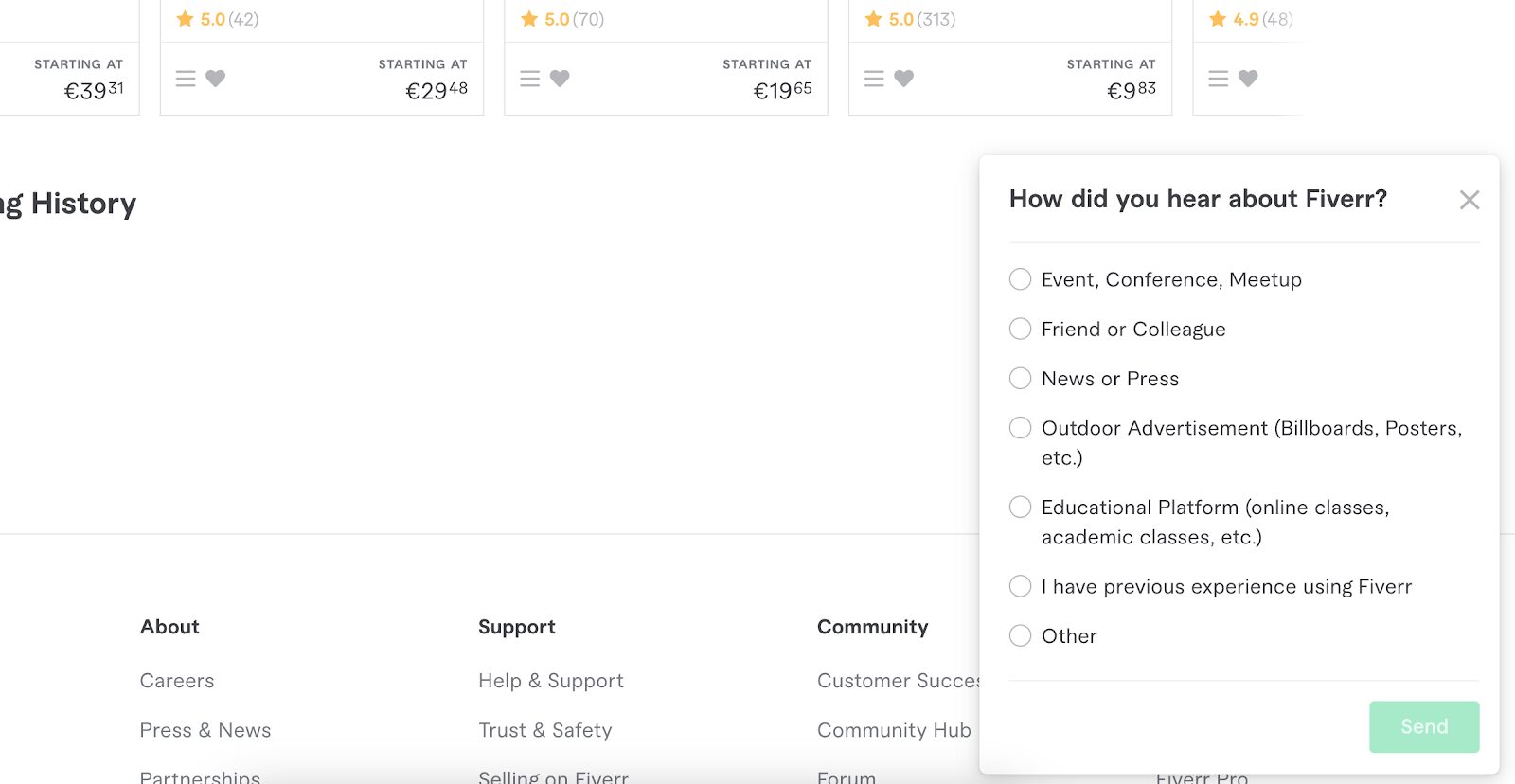
Fiverr’s feedback form is a great example of a satisfaction survey. It asks users where they found out about the service.
This customer survey helps Fiverr gather feedback on where their customers learn about them to measure real attribution.
2. GIMBER

GIMBER’s feedback form aims to understand why customers visit their site and why they’re considering making a purchase.
This information not only provides insights into their target audience but also enables more effective targeting of advertisements.
3. Flip

Flip’s problem identifier feedback form is displayed on an exit-intent popup for visitors who are about to leave the website without making a purchase.
It helps them to better understand why a customer has chosen not to go forward with their service. This valuable insight can help the Flip team understand what the roadblock might be for their audience.
4. MailTag

MailTag’s user-friendly NPS survey is simple yet effective.
The visitor can easily input their answer to the question, and there’s an optional form field where they can extend their response.
5. Urban Outfitters

Urban Outfitters’ user experience feedback form is the epitome of simplicity. It appears as a sidebar, so the visitor can easily close it or choose to go forward and provide feedback.
Note that in the copy, they highlight that it will only take a couple of minutes, addressing a major objection people have to feedback forms.
6. The Farmer’s Dog

The Farmer’s Dog problem identifier feedback form appears for visitors who started to fill out their quiz but didn’t finish completing it or make a purchase. And it’s all about helping (and saving these visitors).
This great feedback form helps them get to know their customers and their needs better so they can improve their services.
7. Mailchimp
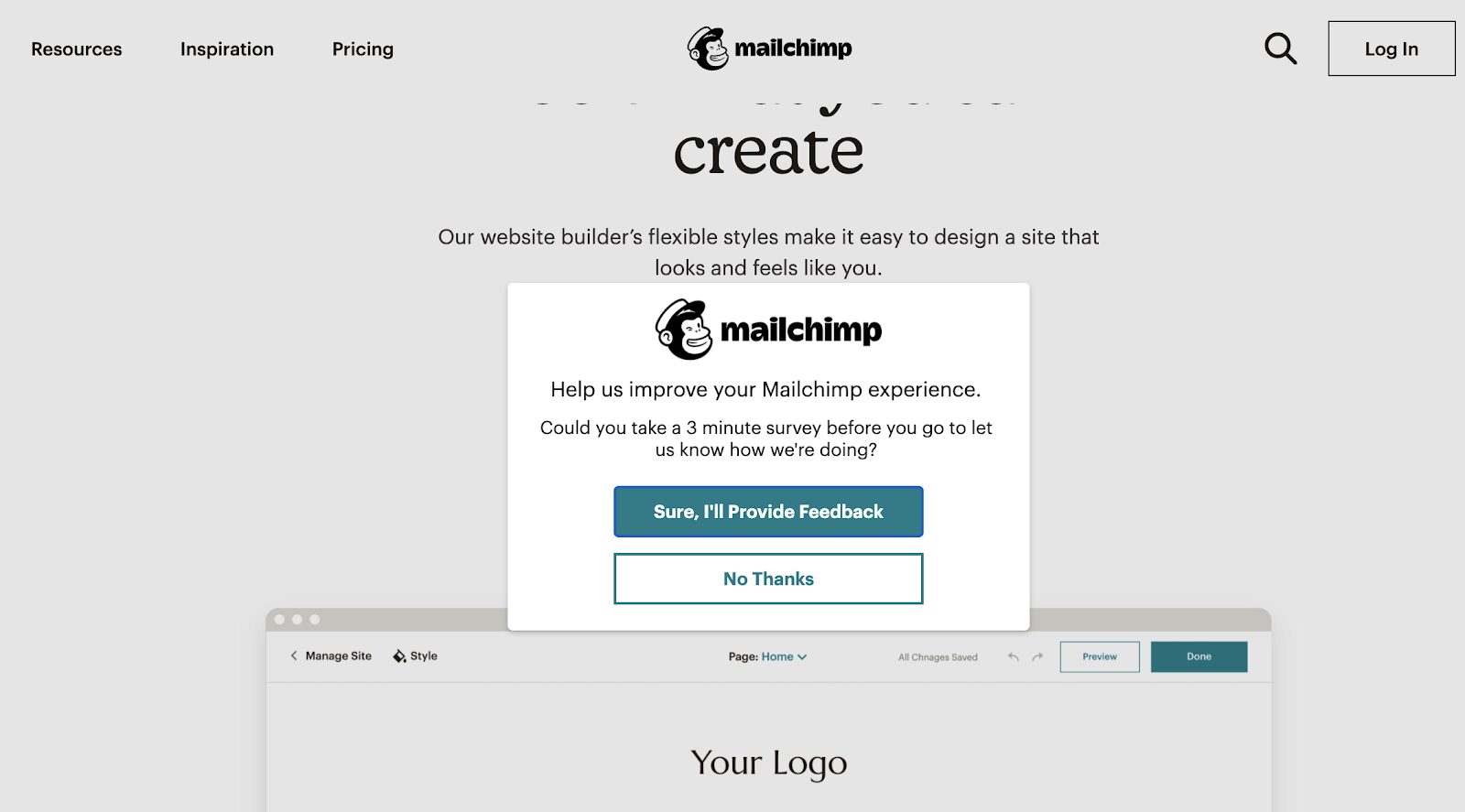
Mailchimp’s online surveys are clearly on the spot. The visitor can submit feedback by clicking on the “Sure, I’ll Provide Feedback” button.
Note how they highlight that it only takes 3 minutes, ensuring the visitor knows it won’t eat up too much of their time.
8. Google Meet

Google Meet’s NPS survey appears after the visitor ends a call, so they can immediately provide feedback about their experience.
It’s a great tactic to encourage users to share feedback while it’s still fresh.
9. SeanWes

SeanWes’s feedback form helps to gather insights into their visitors’ occupations, giving them more information about their target audience.
Armed with this knowledge, they can tailor their offerings, content, and marketing strategies to resonate more effectively with them.
10. Kettle Gifts

Kettle Gifts nails the personal touch. Right at the top of their popup, they include a friendly photo and name, instantly creating a human connection. It doesn’t feel like just another generic survey—it feels like someone real is asking for your thoughts.
The popup is also smart in what it asks. It prompts visitors to give constructive feedback on things like pricing, the browsing experience, or any site-related issues. These aren’t just random questions—they’re targeted to uncover valuable insights that can directly improve the user experience.
11. Hajoutkell
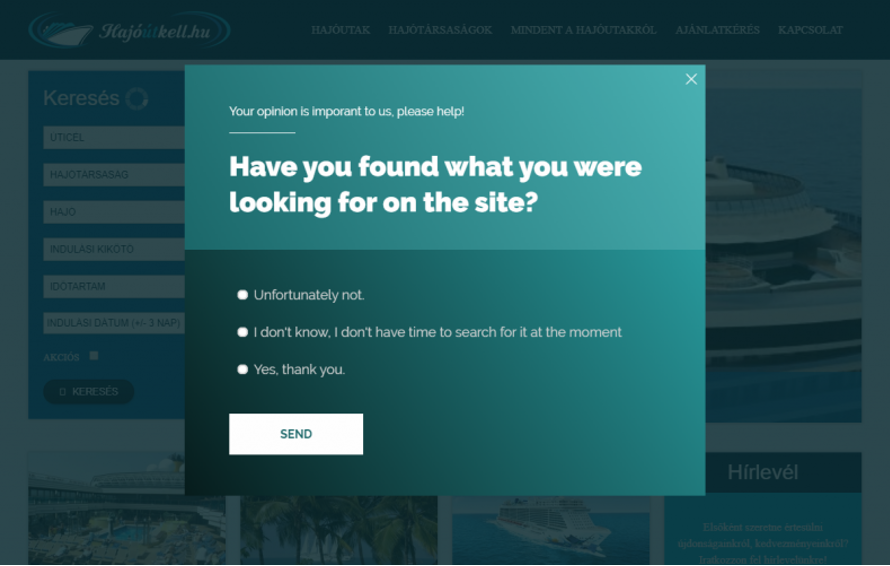
Hajoutkell knows how to grab attention. They use bold, high-impact colors that stand out and make their website feedback form hard to ignore. In a sea of beige and gray, this visual choice makes a difference.
The headline they use—“Your opinion is important to us”—hits the right emotional note. It immediately tells the visitor that their voice matters. Combined with short and clear text, it makes the purpose of the form obvious, reducing any hesitation to participate. The result? More responses and better data.
12. Thredup
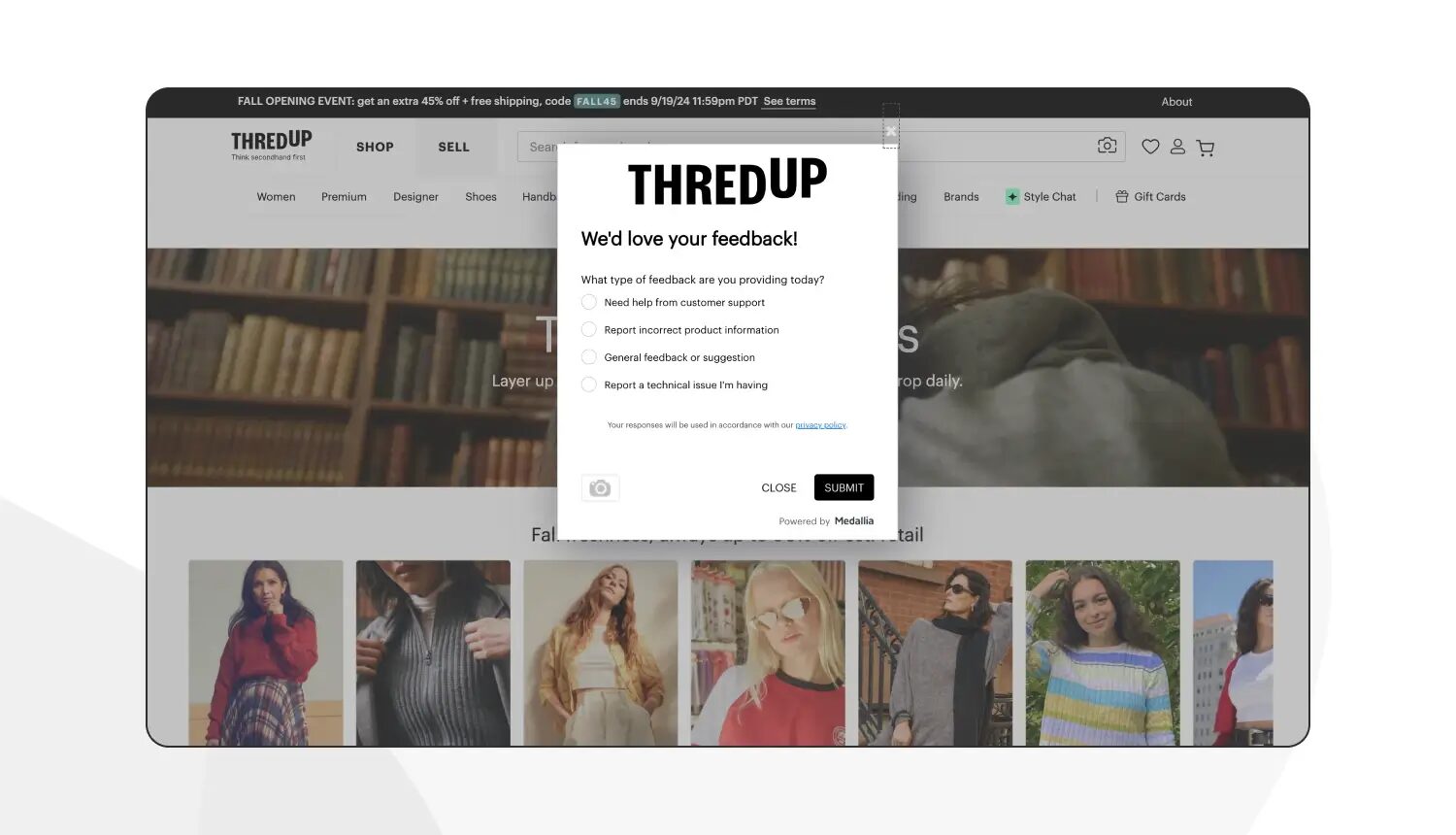
Thredup’s feedback form is clean, structured, and practical. Right off the bat, it asks the user to categorize their feedback. Are they reporting an issue, making a suggestion, correcting product info, or reaching out to customer support?
This small step streamlines the entire process. It makes life easier for the visitor and helps the team on the backend sort and act on the feedback faster. It’s a win-win—customers feel heard, and the company gets organized, actionable insights.
13. Adidas
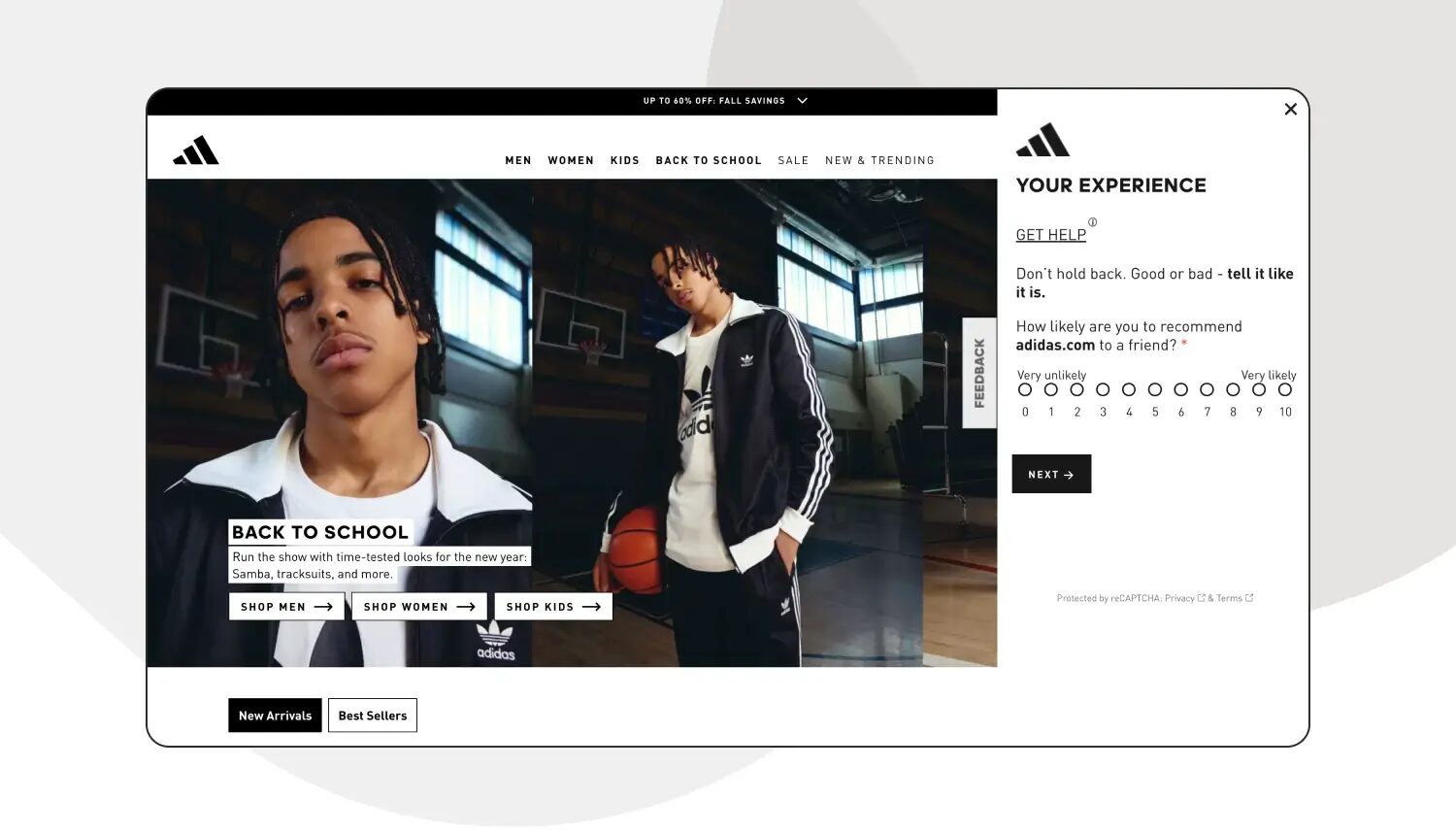
Adidas keeps it comprehensive yet simple. Their popup digs into the overall shopping experience by asking about satisfaction, brand recommendations, and how customers perceive the brand’s sustainability efforts.
They also include a rating scale, room for open-ended comments, and some light demographic questions. This multi-layered approach allows Adidas to gather both quantitative and qualitative data, which helps paint a fuller picture of customer sentiment.
14. Thinx

Thinx takes a different approach by using a subtle popup at the bottom of the page. The question is straightforward: “How did you hear about us?” It’s a small ask, but incredibly insightful.
This helps the team understand which of their marketing channels are driving traffic. Knowing where your visitors come from is crucial if you want to double down on what’s working or shift resources from what’s not. It’s a simple yet effective way to let the data guide strategy.
15. Reebok
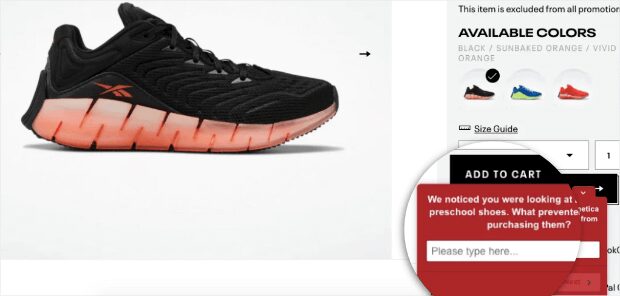
Reebok goes straight to the heart of the issue: why didn’t you buy? Their popup appears on product pages and asks the visitor what stopped them from completing the purchase.
Instead of offering predefined options, they leave an open field where users can type their answers. This invites honest, nuanced feedback that can reveal friction points in the shopping experience—whether it’s pricing, sizing, lack of info, or something else entirely. It’s a smart move for any brand that wants to turn abandoned interest into future conversions.
How to design your own feedback form?
Now let’s see a few best practices you can implement to easily create your own feedback form.
1. Keep it short and simple
In customer feedback, simplicity is often the best route.
Keep your form fields to a minimum and stay concise to improve response rates and minimize the risk of survey fatigue among respondents.
2. Use clear and consistent language
The language you use in your feedback forms greatly influences the accuracy and reliability of the responses you receive.
Clear, straightforward language ensures respondents can answer honestly without confusion.
Avoid using technical jargon or brand-specific terms, as they may confuse participants and skew the results. The aim is to make the survey effortless to complete.
3. Choose the right question types
The types of questions you choose can significantly impact the quality of responses you collect.
Rating scales are effective for measuring satisfaction or agreement levels, while multiple-choice questions with suggestion boxes offer quick and straightforward response options so you can gain insight immediately.
Consider implementing features like piping and routing to enhance the survey experience, allowing respondents to skip irrelevant questions and focus on the parts that apply to them.
Recommended reading: 30 Customer Feedback Questions to Ask (& Tools to Use)
The best customer feedback form templates
OptiMonk enables you to create forms, surveys, and quizzes that include multimedia elements and present questions one at a time, ensuring a smooth user experience.
Here are some feedback form samples to get you started.
6 tips for encouraging customers to provide feedback
Despite the immense value that customer feedback brings to businesses, it can sometimes be challenging to encourage customers to participate in surveys.
Here are some strategies to effectively motivate customers to engage with surveys:
1. Offer incentives
Providing customers with incentives can significantly boost survey participation rates. Consider offering small rewards such as sticker packs, e-gift cards, or access to survey results—people are curious, after all!
Instant rewards can also serve as immediate gratification, encouraging customers to complete the survey right away.
2. Personalize surveys
Tailoring surveys with customer-centric language helps create a more personalized experience.
When customers feel like the survey is designed specifically for them, they’re more likely to engage and provide meaningful feedback.
3. Customize prompts
Customize survey prompts based on each customer’s unique business or preferences.
By addressing their specific interests or pain points, you can make the survey more relevant and interesting for them.
4. Incorporate gamification
Adding gamification elements such as challenges, rewards, or interactive elements can make the survey experience more engaging and enjoyable for customers.
Gamified surveys can increase motivation and encourage repeat participation.
5. Include branded content
Incorporating your brand’s visual elements, messaging, and tone throughout the survey can reinforce your brand identity and make the survey experience more cohesive and memorable for customers.
6. Provide a clear progress indicator
Including a clear progress bar or indicator helps customers understand how much of the survey is remaining, which reduces survey abandonment rates.
Transparency about the survey’s length can also help manage customer expectations and encourage completion.
FAQ
How do you write a customer feedback form?
When writing a feedback form, keep it short to encourage more responses and use simple language to avoid bias. Consider using a progress bar and customizing the form to your audience’s preferences. Avoid overwhelming users with too many questions and aim for a seamless and personalized feedback experience.
What does a good feedback form look like?
A good feedback form is characterized by straightforward language, clear survey design, and specific but easy-to-understand questions. This ensures that customers better understand the questions and provide unbiased responses.
Wrapping up
We hope this guide helped you understand what makes a great customer feedback form!
Whether you just want to implement a basic feedback form or you’re looking for something more complex, use the tips in this article to create a form your customers will happily fill out.
OptiMonk is a great feedback form builder, so don’t hesitate to sign up for a free account today to start collecting feedback!
Migration has never been easier
We made switching a no-brainer with our free, white-glove onboarding service so you can get started in the blink of an eye.
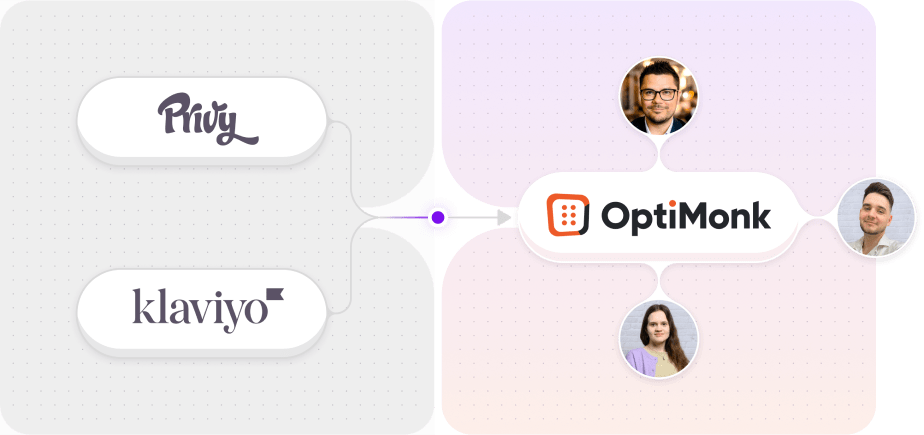
What should you do next?
Thanks for reading till the end. Here are 4 ways we can help you grow your business:
Boost conversions with proven use cases
Explore our Use Case Library, filled with actionable personalization examples and step-by-step guides to unlock your website's full potential. Check out Use Case Library
Create a free OptiMonk account
Create a free OptiMonk account and easily get started with popups and conversion rate optimization. Get OptiMonk free
Get advice from a CRO expert
Schedule a personalized discovery call with one of our experts to explore how OptiMonk can help you grow your business. Book a demo
Join our weekly newsletter
Real CRO insights & marketing tips. No fluff. Straight to your inbox. Subscribe now
Barbara Bartucz
- Posted in
- Conversion
Partner with us
- © OptiMonk. All rights reserved!
- Terms of Use
- Privacy Policy
- Cookie Policy
Product updates: January Release 2025








